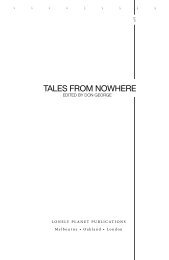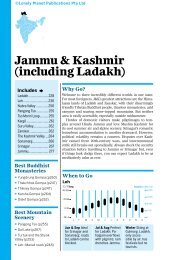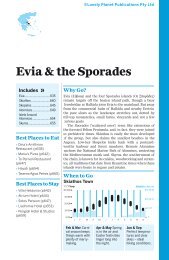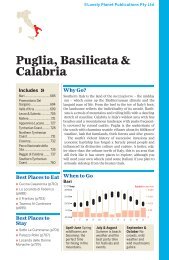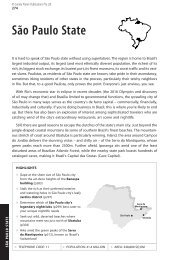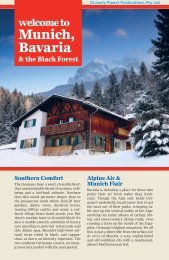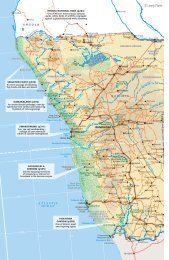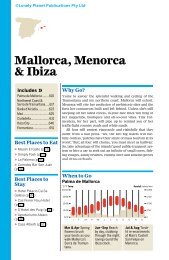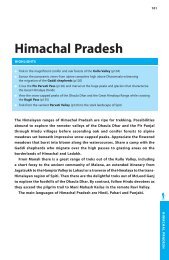Puglia, Basilicata & Calabria - Lonely Planet
Puglia, Basilicata & Calabria - Lonely Planet
Puglia, Basilicata & Calabria - Lonely Planet
Create successful ePaper yourself
Turn your PDF publications into a flip-book with our unique Google optimized e-Paper software.
© <strong>Lonely</strong> <strong>Planet</strong><br />
695<br />
<strong>Puglia</strong>, <strong>Basilicata</strong><br />
& <strong>Calabria</strong><br />
Italy’s south is out on a limb; this is the heel of Italy, a hotter, edgier place than the urbane,<br />
sophisticated and, dare we suggest, mildly smug north. But the traditional north–south<br />
divide is starting to blur. Tuscany in the ’80s, Umbria in the ’90s…many of today’s trendspotters<br />
feel the south and, in particular, <strong>Puglia</strong>, is the new darling of travellers in the know<br />
and holiday-home Brits.<br />
This is not yet another dolce vita region that can be glibly described with a few apt<br />
superlatives. There are plenty of reminders of unrelenting poverty and plenty to regret –<br />
such as the stark urban sprawl of Brindisi and the industrial development around<br />
Potenza and Taranto.<br />
The flip side is a rich and varied portfolio of plains in the south, mountains in the north<br />
and a dramatic and varied coastline. The people are similarly diverse, although share a fierce<br />
local pride, reflecting Greek, Spanish and Turkish influences in their culture and cuisine.<br />
<strong>Basilicata</strong> is a crush of mountains and rolling hills with a dazzling stretch of coastline.<br />
<strong>Calabria</strong> is Italy’s wildest area with fine beaches, subtropical vegetation and a mountainous<br />
landscape with peaks frequently crowned by ruined castles. <strong>Puglia</strong>’s charms include 800km<br />
of coastline beneath limestone cliffs, interspersed with thick forests and olive groves.<br />
This is an area that still feels like it has secret places to explore, although you will need your<br />
own wheels (and some Italian) if you plan to seriously sidestep from the beaten track.<br />
HIGHLIGHTS<br />
Dip into the Disney-style scenario of the gnome-size<br />
trulli dwellings in Alberobello ( p713 ), <strong>Puglia</strong><br />
Wonder at ornate baroque facades in Lecce ( p721 )<br />
Immerse yourself in nature exploring the verdant<br />
Promontorio del Gargano ( p696 )<br />
Discover one of <strong>Calabria</strong>’s most characterful old<br />
centres in seaside Tropea ( p754 )<br />
Vanish into the vast hills of La Sila ( p748 ) in <strong>Calabria</strong>,<br />
and the Parco Nazionale del Pollino in both<br />
<strong>Basilicata</strong> ( p741 ) and <strong>Calabria</strong> ( p743 )<br />
Drive or trek into the wilds of mysterious<br />
Aspromonte ( p750 )<br />
Explore the otherworldly sassi (former cave<br />
dwellings) of Matera ( p733 ) in <strong>Basilicata</strong><br />
POPULATION: PUGLIA 4.07 MILLION;<br />
BASILICATA 596,500; CALABRIA 2.01 MILLION<br />
Tropea<br />
Promontorio<br />
del Gargano<br />
Matera<br />
Aspromonte<br />
Parco Nazionale<br />
del Pollino<br />
La Sila<br />
Alberobello<br />
Lecce<br />
AREA : PUGLIA 19,348 SQ KM; BASILICATA<br />
9992 SQ KM; CALABRIA 15,080 SQ KM<br />
PUGLIA, BASILICATA<br />
& CALABRIA
PUGLIA, BASILICATA<br />
& CALABRIA<br />
696 PUGLIA •• Promontorio del Gargano<br />
PUGLIA<br />
<strong>Puglia</strong> is sun-bleached landscapes, seascapes<br />
and silver olive groves; hilltop and coastal<br />
towns; factories and power stations; tarantella<br />
(mesmerising local folk music); fields<br />
stippled with a dazzle of spring flowers;<br />
cigarette-and-people-smuggling; elderly men<br />
on benches; elderly women mopping their<br />
front step; plenty of bicycles; summer carnivals;<br />
immigrants arriving by boat; and dialects<br />
that change from town to town.<br />
Italy’s heel has the country’s longest coastline.<br />
Two seas meet here: the Adriatic to the<br />
east and the Ionian to the south. It’s legendary<br />
for its food, in a land where the cuisine is allimportant:<br />
olive oil, grapes tomatoes, aubergines,<br />
artichokes, peppers, salami, fungi, olives<br />
and fresh seafood strain its table. The region<br />
looks out to sea and bears the marks of many<br />
invading overseas visitors: the Normans,<br />
the Spanish, the Turks, the Swabians and<br />
the Greeks. <strong>Puglia</strong> feels authentic – in some<br />
places it’s rare to hear a foreign voice. In July<br />
and August it becomes a huge party, with<br />
thousands of Italian tourists heading down<br />
here for their annual break.<br />
They’re here to bask on some of Italy’s<br />
loveliest coastline, from the dramatic<br />
Promontorio del Gargano to the whitesand<br />
beaches of the Penisola Salentina.<br />
Geologically speaking the region resembles<br />
Croatia – the land mass to which it was once<br />
joined – rather than the rest of Italy. The<br />
coast alternates between glittering limestone<br />
precipices and long beaches edged by waters<br />
veering between emerald-green and dusky<br />
powder blue.<br />
There are festivals here throughout the<br />
year, but fabulous events, concerts (often<br />
tarantella), and sagre (festivals, usually involving<br />
food) take place virtually every<br />
night in July and August. Check the www<br />
.quisalento.it website for a schedule.<br />
History<br />
At times <strong>Puglia</strong> feels Greek – and for good<br />
reason. This tangible legacy dates from when<br />
the Greeks founded a string of settlements<br />
along the Ionian coast in the 8th century<br />
BC. A form of Greek dialect (Griko) is still<br />
spoken in some towns southeast of Lecce.<br />
Historically, their major city was Taras<br />
(Taranto), settled by Spartan exiles who<br />
lonelyplanet.com<br />
dominated until they were defeated by the<br />
Romans in 272 BC.<br />
The long coastline made the region vulnerable<br />
to conquest. The Normans left their fine<br />
Romanesque churches, the Swabians their<br />
fortifications, and the Spanish their flamboyant<br />
baroque buildings. No one, however,<br />
knows exactly the origins of the extraordinary<br />
16th-century, conical-roofed stone houses,<br />
the trulli, unique to <strong>Puglia</strong>.<br />
Apart from invaders and pirates, malaria<br />
was long the greatest scourge of the south,<br />
forcing many towns to build away from the<br />
coast and into the hills. After Mussolini’s seizure<br />
of power in 1922 following WWI, the<br />
south became the frontline in his ‘Battle for<br />
Wheat’. This initiative was aimed at making<br />
Italy self-sufficient when it came to food, following<br />
the sanctions imposed on the country<br />
after its conquest of Ethiopia – <strong>Puglia</strong> is<br />
now covered in wheat fields, olive groves and<br />
fruit arbours.<br />
PROMONTORIO DEL GARGANO<br />
The coast surrounding the promontory seems<br />
permanently bathed in a pink-hued, pearly<br />
light, providing a painterly contrast to the<br />
sea which softens from intense to powder<br />
blue as the evening draws in. It’s one of Italy’s<br />
most beautiful areas, encompassing white<br />
limestone cliffs, fairy-tale grottoes, sparkling<br />
sea, ancient forests, and tangled, fragrant<br />
maquis. Once connected to what is now<br />
Dalmatia, the ‘spur’ of the Italian boot has<br />
more in common with the land mass across<br />
the sea than with the rest of Italy. Creeping<br />
urbanisation was halted in 1991 by the creation<br />
of the Parco Nazionale del Gargano . Aside<br />
from its magnificent display of flora and<br />
the primeval forests of Quarto, Spigno and<br />
Umbra, the park takes in miracle town San<br />
Giovanni Rotonda (see p703 ) and the historic<br />
pilgrimage destination of Monte Sant’Angelo.<br />
OUR TOP FIVE CENTRO STORICOS<br />
(HISTORIC CENTRES) IN PUGLIA<br />
Locorotondo ( p714 )<br />
Martina Franca ( p715 )<br />
Ostuni ( p717 )<br />
Vieste ( p701 )<br />
Lecce ( p721 )



